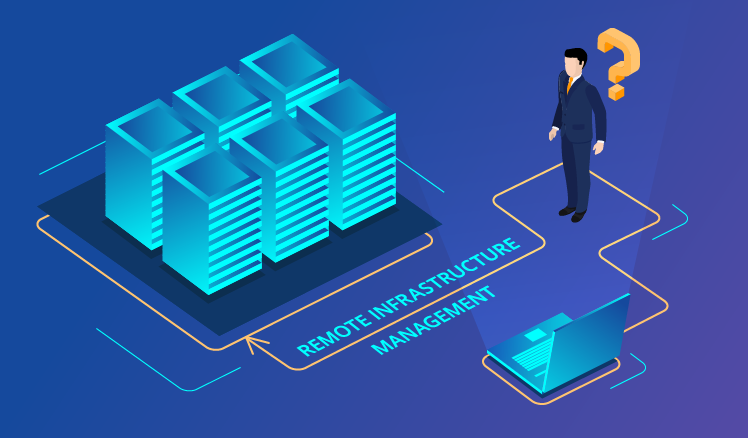Customer’s Guide on Remote Infrastructure Management Services
According to MarketsandMarkets, the market size of remote infrastructure management (RIM) is expected to grow from USD 23.65 billion in 2017 to USD 41.27 billion by 2022. Why have remote infrastructure management services become such a hot ticket? What are RIM’s challenges? And how to choose the right vendor? Let’s get these customer essentials straightened out.

Some CIOs find remote infrastructure management unusual and prefer to follow the same old formula, keeping an in-house IT department. Bill Piatt, CIO of the International Finance Corporation (IFC), however, claims that RIM has always been mainstream. “Why would anyone think this [RIM] is unusual? All infrastructure is managed remotely. No one's ever sitting inside your data center anyway, even if it is in your basement. Admins are working from a different building or a different city or, if it's a weekend, logging on from home. Remote infrastructure management is something that virtually every organization does every single day. But people somehow think there's a material difference if that work is done by another company."
Remote infrastructure management benefits
Still, there is a difference between in-house and outsourced remote infrastructure management, and it’s reflected in the RIM benefits below.
Geography coverage
Large enterprises and medium-sized businesses operate across geographies, and RIM covers their IT infrastructure located in different parts of the world.
Reduced IT spending
Companies opting for remote infrastructure management services admit saving from 20 to 60% on office space, labor and operational costs.
Operational improvement
It’s projected that at least 60% of IT vendors will be offering remote infrastructure management services by the end of 2018. Such a tough competition means that vendors offer cutting-edge tools, technical expertise and advanced methodologies to lure customers. It means, that a good RIM vendor can raise your tech support to another level. Furthermore, RIM customers get access to skilled manpower that can easily be scaled up and down, depending on specific business requirements.
As a part of their offerings, RIM services providers often perform deep infrastructure analysis that helps to detect and eliminate operational issues.
Basically, RIM lifts the burden of IT infrastructure management from CIOs’ shoulders, allowing them to concentrate on developing and implementing an IT strategy.
Remote infrastructure management challenges
Regardless of all the advantages of remote infrastructure management, CIOs should understand whether they are able to address the challenges that infrastructure management outsourcing may pose to their companies.
Limited cost savings
Different infrastructure management services have unequal outsourcing potential. For example, network services, internal help desk and server management are good for outsourcing, because all IT operations there are relatively standard. But what if you need desktop management? Sometimes unresponsive computers need physical presence of an IT specialist. And it will be too costly to invite a remote worker from overseas regularly.
Earlier, we talked about labor cost savings brought by outsourcing infrastructure management. However, it’s just 20% of IT infrastructure expenses. Howard Rubin, CEO of the consultancy Rubin Worldwide and an MIT researcher says that "if you save 30% on labor, which is just 20% of the overall spend, you end up saving 6% on infrastructure costs". CIOs should do the math and determine, what infrastructure management services they want to outsource and if it is really worth the deal.
Necessity to revise a contract
Say, a customer with Microsoft servers wants to move to Linux. In an asset-light cooperation model (when asset ownership is either transferred by the customer to the provider or supplied directly by the provider), such changes have to be negotiated with the RIM provider. Each time the customer wants to make a change to the network topology or server configuration, the RIM contract has to be reviewed by the provider and amended accordingly. “It's a big administrative discussion rather than a technology decision," says Piatt.
Problematic training of a remote team
An asset-heavy remote infrastructure management model (when a customer owns all IT assets) also may become problematic. Although it’s easier to make infrastructural changes, training remote employees to keep them up to date with those changes is challenging. Suppose, your business is in Austin, TX and the RIM provider is in New Delhi. Ten-and-a-half-hour time difference makes it difficult to choose scheduled webinars and teleconferences in a way that will suit both parties.
Choosing the right vendor
Whether your company will reap the benefits of remote infrastructure management or face its downsides largely depends on what vendor you will choose. If a remote team misses something on the infrastructure side, it can cost a customer millions.
Dave Bondo, a cloud solutions consultant at LiftOffIT, suggests the following essentials that should be included in remote infrastructure management package:
- 24/7 monitoring of customer’s servers and OS.
- Alert validation and escalation.
- Runbook management.
- OS patching.
- Antivirus updates.
- Verifying completion of backups.
- Integration with a customer’s service desk tool.
- Dashboards and reporting.
Excellent service delivery is not the only thing to look for in a prospective vendor. Look for the company that knows the meaning of the word “partnership”. Sometimes, RIM services providers offer a standard packet of services which doesn’t reflect your infrastructural needs or want a full control of your infrastructure without keeping you in the loop. A true infrastructure management partner will interview you to learn what particular services your business needs. Such a vendor understands that you don’t want to hand everything over. Instead, you search for an opportunity to focus on the management of the core functions that bring your company money, and, at the same time, get sufficient insights on what’s going on in your IT environment.
On a final note
Markets become highly competitive across industries. To attract new customers and retain loyalty of the existing ones, businesses have to concentrate on their core offers and services. In such a case, companies risk to get lower quality of infrastructure management by the in-house team. To ensure that your IT system is at top performance, consider remote infrastructure management services by a reliable vendor.

